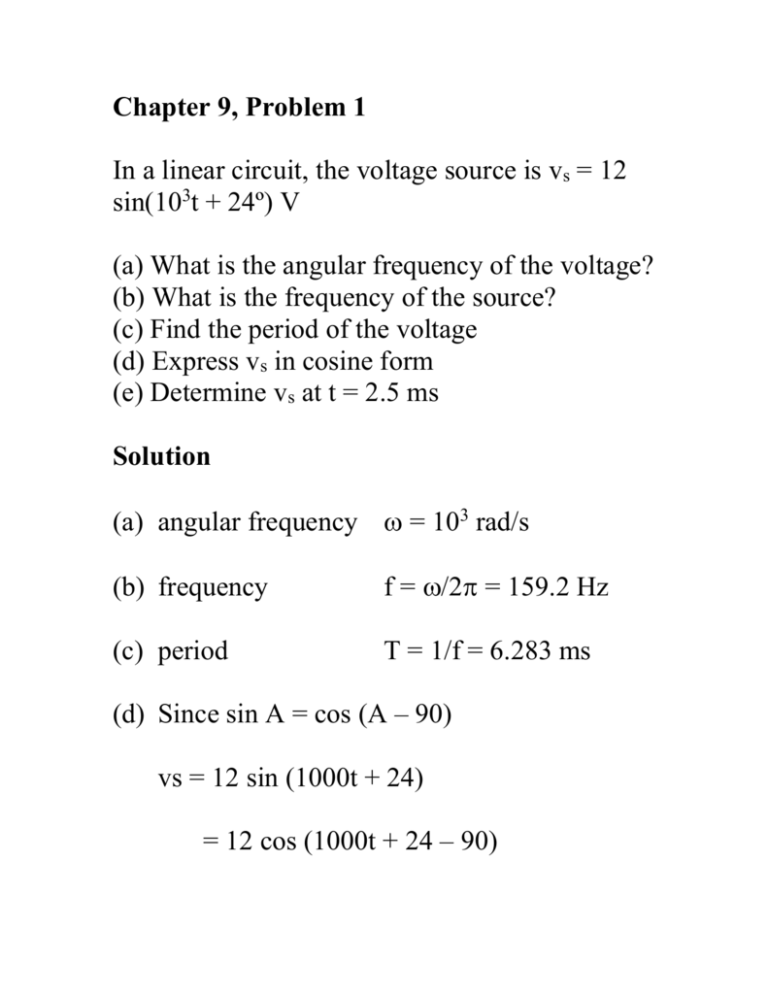week 10
advertisement

Chapter 9, Problem 1 In a linear circuit, the voltage source is vs = 12 sin(103t + 24º) V (a) What is the angular frequency of the voltage? (b) What is the frequency of the source? (c) Find the period of the voltage (d) Express vs in cosine form (e) Determine vs at t = 2.5 ms Solution (a) angular frequency = 103 rad/s (b) frequency f = /2 = 159.2 Hz (c) period T = 1/f = 6.283 ms (d) Since sin A = cos (A – 90) vs = 12 sin (1000t + 24) = 12 cos (1000t + 24 – 90) = 12 cos (1000t - 66º) V (e) vs(2.5 ms) = 12 sin (1000 x 2.5 x 10-3 + 24º) = 12 sin (2.5 + 24º) = 12 sin (143.24º + 24º) = 12 sin 167.24º = 2.65 V Chapter 9, Problem 3. Express the following functions in cosine form. 4 sin (t - 30º) -2 sin 6t -10 sin (t + 20º) Solution 4 sin (t - 30º) = 4 cos (t - 30º - 90º) = 4 cos (t - 90º) -2 sin 6t = 2 cos (t + 90º) -10 sin (t + 20º) = 10 cos (t + 20º + 90º) = 10 cos (t + 110º) Chapter 9, Problem 16. Transform the following sinusoids to phasors -10 cos (4t + 75º) 5 sin(20t - 10º) 4 cos 2t + 3 sin 2t Solution -10 cos (4t + 75º) = 10 cos (4t + 75º - 180º) =10 cos (4t - 105º) The phasor form is 10 <-105º 5 sin(20t - 10º) = 5 cos (20t - 10º - 90º) = 5 cos (20t -100º) The phasor form is 5 <-100º 4 cos 2t + 3 sin 2t = 4 cos 2t + 3 cos (2t - 90º) The phasor form is 4 <0º + 3 <-90º = 4 – j3 = 5 <-36.87º Chapter 9, Problem 17. Express the sum of the following sinusoidal signals in the form of A cos (t + ) with A > 0 and 0 < < 360º (a) 8 cos (5t - 30º) + 6 cos 5t (b) 20 cos (120t + 45º) – 30 sin 120t + 20º) (c) 4 sin 8t + 3 sin (8t - 10º) Solution (a) A = 8 <-30º + 6 <0º = 12.928 – j4 = 13.533 <-17.19 a(t) = 13.533 cos (5t + 342.81º) (b) We know that –sin = cos ( + 90º) B = 20 <45º + 30 <(20º + 90º) = 14.142 + j14.142 – 10.261 + j 28.19 = 3.881 + j 42.33 = 42.51 < 84.76º b(t) = 42.51 cos (120t + 84.77º) (c) C = 4 <-90º + 3 <(-10º - 90º) = - j4 – 0.5209 – j2.954 = 6.974 <265.72 c(t) = 6.974 cos (8t + 265.72º) Chapter 9, Problem 23. Find a single sinusoid corresponding to each of these phasors. V = 40 <-60º V = -30 <10º + 50 <60º I = j 6e-j10º I = 2/j + 10 <-45º Solution v(t) = 40 cos (t - 60º) V = -30 <10º 50 <60º = - 4.54 + j38.09 =38.36 <96.8º v(t) = 38.6 cos (t + 96.8º) I = j 6 <-10º = 6 <(90º - 10º) = 6 <80º i(t) = 6 cos (t + 80º) I = 2/j + 10 <-45º = -j2 + 7.0-71 – j7.071 =11.5 <-52.06º i(t) = 11.5 cos (t – 52.06º) Chapter 9, Problem 28. Determine the current that flows through an 8 resistor connected to a voltage source, vs = 110 cos 377t V Solution i(t) = vs/R = (110 cos 377t)/8 = 13.75 cos 377t A Chapter 9, Problem 29. What is the instantaneous voltage across a 2 F capacitor when the current through it is i = 4 sin (106t + 25º) A ? Solution Z = 1/jC = 1/(j(106)(2 x 10-6) = -j0.5 V = IZ = (4 <25º)(0.5 <-90º) = 2 <-65º Therefore v(t) = 2 sin(106t - 65º) Chapter 9, Problem 30. The voltage across a 4 mH inductor is is v = 60 cos (500 t - 65º) V. Find the instantaneous current through it. Solution Z = jL = j(500)(4 x 10-3) = j2 I = V/Z = (60 <-65º)/(2 <90º) = 30 < -155º Therefore i(t) = 30 cos (500t - 155º) A Chapter 9, Problem 33. A series RL circuit is connected to a 110 V AC source. If the voltage across the resistor is 85 V, find the voltage across the inductor. Solution 110 = √(VR2 + VL2) VL = √(1102 – VR2) = √(1102 – 852) = 69.82 V Chapter 9, Problem 35. If vs = 5 cos 2t V in this circuit, find vo. 2 0.25 F vs 1H Solution Vs = 5 < 0º jL = j(2)(1) = j2 1/(jC) = 1/(j(2)(0.25) = -j2 Vo = Vs x j2/(1 – j2 + j2) = 5 <0º x j2/2 = 5 <0º x 1 <90º = 5 < 90º Thus vo(t) = 5 cos(2t + 90º) = - 5 sin 2t V + vo -







